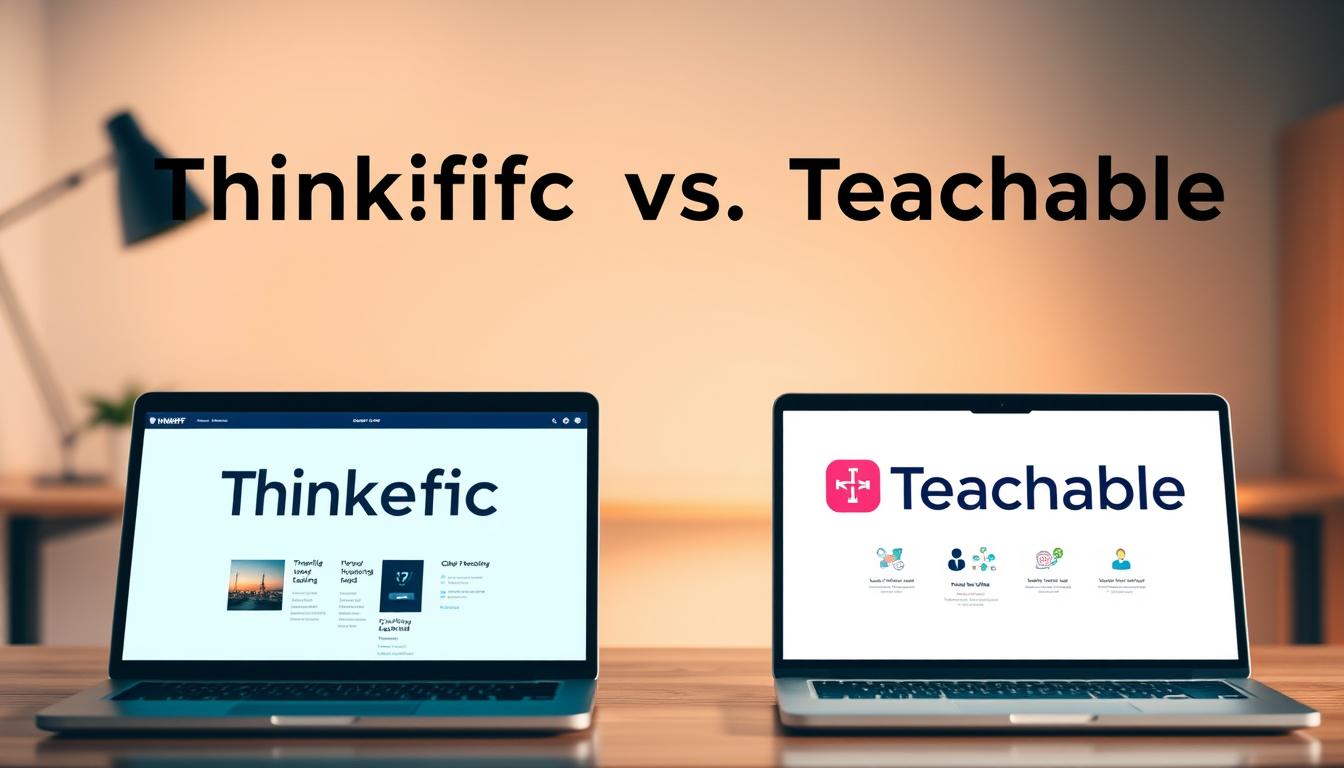In 2025, online education continues to grow, and choosing the right platform for your courses is more important than ever. Two of the most popular options are Thinkific and Teachable. Both platforms offer robust tools for course creation, marketing, and sales, making them ideal for educators and entrepreneurs alike.
While they share many core features, each platform has its unique strengths. Whether you’re focused on design flexibility, pricing, or advanced analytics, understanding these differences can help you make the best choice for your needs.
This article provides a detailed comparison of Thinkific and Teachable, covering features, pricing, user interface, and support options. Our analysis is based on expert reviews and industry data, ensuring you get accurate and actionable insights.
By the end, you’ll have a clear understanding of which platform aligns with your goals, helping you build and grow your online courses effectively.
Key Takeaways
- Both platforms offer strong course creation and marketing tools.
- Pricing structures differ, with varying transaction fees.
- Thinkific provides more design templates and video management options.
- Teachable offers better analytics and reporting features.
- Support options vary, with Thinkific noted for faster response times.
Platform Overview
As the demand for digital learning grows, selecting the right course builder is crucial. Both platforms are cloud-based, ensuring seamless access and automatic updates. This eliminates the need for technical maintenance, allowing creators to focus on their content.
Hosting, security, and course management are handled effortlessly. This means your online course is always accessible and protected. Both platforms support various media types, from videos to PDFs, making them versatile for diverse teaching styles.

One of the standout features is the drag-and-drop interface. This makes it easy for anyone to design and organize their course without coding skills. Whether you’re a beginner or an experienced educator, the intuitive design ensures a smooth experience.
Behind the scenes, both platforms share similar back-end functionalities. This includes automated updates, secure hosting, and user-friendly dashboards. These similarities make them reliable choices for creating and managing online courses effectively.
Understanding the Core Features
The foundation of a successful online course lies in the platform’s core features. These tools determine how easily you can create, manage, and grow your courses. Both platforms offer robust tools, but their strengths lie in different areas.
Course creation is a top priority for educators. Both platforms provide drag-and-drop builders, making it simple to design lessons. However, one platform offers more advanced video management, while the other excels in bulk editing capabilities.

Mobile accessibility is another critical factor. One platform provides apps for both iOS and Android, ensuring students can learn on the go. The other, however, is limited to iOS, which may restrict some users.
“The right platform can transform your course from good to great by offering the tools you need to succeed.”
Third-party integrations are essential for expanding functionality. Both platforms support popular tools like email marketing services and payment gateways. Yet, one stands out with over 90 app integrations, offering more flexibility for advanced users.
Reporting and analytics are vital for tracking progress. One platform provides detailed insights into student performance, while the other focuses on sales metrics. Understanding these differences can help you choose the right fit for your goals.
| Feature | Platform A | Platform B |
|---|---|---|
| Course Creation | Advanced video management | Bulk editing capabilities |
| Mobile Accessibility | iOS and Android apps | iOS only |
| Integrations | Over 90 apps | Limited to essential tools |
| Reporting Tools | Student performance insights | Sales metrics focus |
Each platform has its pros and cons. Evaluating these core features will help you make an informed decision. Whether you prioritize design flexibility, mobile access, or advanced analytics, understanding these tools is key to your success.
Ease of Use and User Interface
A smooth user experience is essential for both course creators and students. The interface of an online course platform plays a critical role in ensuring efficiency and satisfaction. Both platforms offer clean, modern designs, but their approaches to navigation and dashboard organization differ slightly.

Admin Dashboard Overview
The admin dashboard is the control center for managing your courses. One platform features a persistent side menu, allowing quick access to key sections like course creation, analytics, and settings. This design ensures that even beginners can navigate the platform with ease.
On the other hand, the second platform offers a more modular approach. While it provides extensive options, some features are located in separate sections. This can be beneficial for advanced users who prefer a detailed layout but may require a slight learning curve for newcomers.
Navigation and Intuitiveness
Navigation is a standout feature for both platforms. One platform uses a straightforward, step-by-step process for setting up courses. This makes it ideal for users who prioritize simplicity and speed.
The second platform, however, offers more customization options. Its drag-and-drop editor allows creators to design course pages with greater flexibility. This is particularly useful for those who want to create a unique learning experience for their students.
| Feature | Platform A | Platform B |
|---|---|---|
| Dashboard Layout | Persistent side menu | Modular sections |
| Navigation Style | Step-by-step process | Drag-and-drop editor |
| Ease of Use | Beginner-friendly | Advanced customization |
Both platforms are intuitive, but subtle differences can impact overall usability. Whether you’re a beginner or an experienced creator, understanding these nuances will help you choose the right platform for your needs.
Course Creation and Builder Tools
Creating engaging online courses starts with the right tools. A course platform with intuitive features can simplify the process, allowing you to focus on delivering quality content. Both platforms offer powerful drag-and-drop builders, making it easy to assemble lessons without technical expertise.
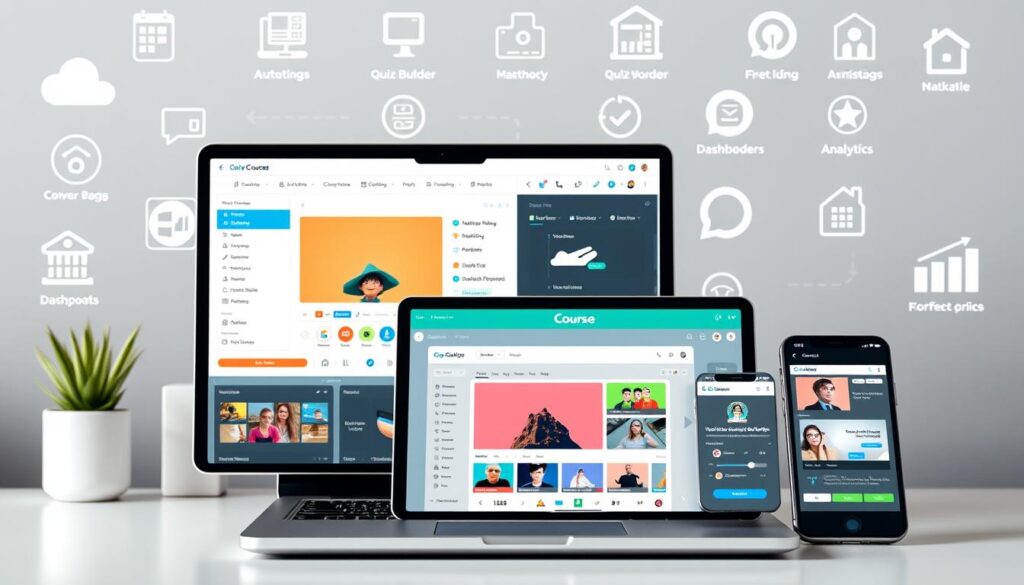
Drag-and-Drop Functionality
The drag-and-drop builder is a game-changer for educators. It lets you organize lessons, quizzes, and multimedia seamlessly. Whether you’re adding videos, PDFs, or interactive files, the process is straightforward and efficient. This feature is especially helpful for beginners who want to create professional-looking courses quickly.
Bulk Upload and Video Library
Managing content is easier with bulk upload options. You can add multiple files at once, saving time and effort. One platform stands out with its video library feature, which allows you to reuse videos across courses. This is a significant advantage for creators who frequently update or repurpose their content.
“The ability to reuse videos has saved me countless hours. It’s a feature I didn’t know I needed until I started using it.”
In comparison, the other platform offers robust import tools but lacks a dedicated video library. This difference can impact how efficiently you manage your course materials. Flexibility is another key factor. Both platforms let you combine multiple content types in a single lesson, such as videos, quizzes, and downloadable resources. This ensures a dynamic learning experience for your students.
User reviews highlight the speed and ease of course creation on both platforms. Whether you’re building your first course or scaling your online school, these tools provide the functionality you need to succeed.
Student Engagement and Learning Tools
Engaging students is the cornerstone of effective online learning. The right tools can make all the difference in keeping learners motivated and involved. Both platforms offer a variety of features designed to enhance participation and foster a sense of community.

Advanced Quiz Options
Quizzes are a powerful way to assess understanding and reinforce learning. One platform stands out with its advanced quiz functionalities. It supports multiple question formats, including multiple-choice, true/false, and open-ended questions. Additionally, it offers randomized question banks, ensuring each student gets a unique assessment experience.
Another notable feature is the integration with exam solutions. This allows educators to create comprehensive tests that align with their course objectives. These tools make it easier to track progress and identify areas where students may need extra support.
Interactive and Community Features
Interactive elements are key to keeping students engaged. Both platforms provide tools like assignments and surveys, which encourage active participation. Assignments allow learners to apply their knowledge, while surveys gather feedback to improve the course experience.
Community-building features are equally important. Discussion boards and group activities foster collaboration among students. These tools create a sense of belonging, which can significantly enhance the learning journey.
“Interactive features not only engage students but also create a dynamic learning environment that encourages growth.”
| Feature | Platform A | Platform B |
|---|---|---|
| Quiz Formats | Multiple formats, randomized banks | Standard formats, fixed questions |
| Interactive Tools | Assignments, surveys, discussion boards | Assignments, limited community features |
| Community Building | Group activities, collaboration tools | Basic discussion boards |
Choosing the right platform depends on your specific needs. If advanced quizzes and robust community features are priorities, one platform may be the better option. However, both offer tools that can significantly enhance student engagement and learning outcomes.
Sales and Marketing Capabilities
Effective sales and marketing strategies are essential for the success of any online course. Both platforms provide robust tools to help creators promote their courses, optimize conversions, and build a strong brand presence. Understanding these features can significantly impact your course’s growth and revenue.

Customizable Sales Pages
Customizable sales pages are a game-changer for branding and conversion optimization. One platform offers a drag-and-drop editor, allowing creators to design pages that align with their unique style. This flexibility ensures your course stands out in a competitive market.
Dynamic FAQ sections and customizable checkout options further enhance the user experience. These features not only build trust but also address potential concerns, increasing the likelihood of conversions.
Email and Affiliate Integration
Email automation is a powerful tool for nurturing leads and engaging students. Both platforms integrate seamlessly with popular email marketing services, enabling creators to send targeted campaigns effortlessly.
Affiliate management is another standout feature. One platform includes affiliate capabilities in its basic plan, making it accessible to all creators. This allows you to expand your reach by leveraging your network of affiliates.
- Compare the sales and marketing tools offered by both platforms.
- Explain how customizable sales pages can help in branding and conversion optimization.
- Describe email automation features and affiliate integration functionalities.
- Highlight additional benefits and limitations mentioned in the review data for both platforms.
Both platforms excel in providing the necessary tools for effective sales and marketing. Whether you prioritize design flexibility or advanced automation, understanding these features will help you choose the right plan for your needs.
Mobile App and Accessibility
Mobile accessibility is a critical factor for modern online learning platforms. With students and creators constantly on the go, having a reliable mobile app can make or break the learning experience. Both platforms offer mobile solutions, but their approaches differ significantly.
One platform stands out with its branded mobile app option. This feature allows creators to maintain their brand identity while providing students with a seamless learning experience. The app supports offline access, ensuring learners can continue their studies even without an internet connection.

In contrast, the other platform offers a more limited mobile solution. While it provides basic functionality, it lacks the branding and offline access features. This can be a drawback for educators who prioritize a fully integrated experience for their students.
“A branded mobile app not only enhances accessibility but also strengthens the connection between students and the course creator.”
App responsiveness and design are also key considerations. One platform’s app has received higher ratings for its intuitive interface and smooth navigation. The other, while functional, has faced criticism for its clunky design and slower performance.
| Feature | Platform A | Platform B |
|---|---|---|
| Branded App | Yes | No |
| Offline Access | Supported | Not Supported |
| App Ratings | 4.6 stars | 2.0 stars |
Mobile readiness is a key decision point for many educators in today’s market. Whether you prioritize branding, offline access, or app design, understanding these differences will help you choose the right platform for your needs.
Third-Party Integrations and Compatibility
Third-party integrations can significantly enhance the functionality of your online course platform. These tools allow you to connect with external services, streamlining your workflow and improving efficiency. Whether it’s email marketing, payment processing, or analytics, integrations play a crucial role in scaling your courses.
One platform offers native integrations with popular email marketing services, making it easier to manage campaigns directly from your dashboard. This eliminates the need for manual data transfers and ensures seamless communication with your audience. In contrast, the other platform relies on external solutions like Zapier for broader connectivity, offering flexibility but requiring additional setup.

Payment gateways are another critical integration. Both platforms support popular options like Stripe and PayPal, ensuring smooth transactions for your students. However, one platform provides more advanced features, such as automated tax handling and VAT collection, which can be a game-changer for international creators.
“Integrations are the backbone of efficient course management. They save time, reduce errors, and allow creators to focus on what matters most—delivering quality content.”
Marketing platforms also benefit from integrations. One platform offers over 90 app integrations, including tools for affiliate marketing and analytics. This allows creators to track performance and optimize their strategies effectively. The other, while limited in native integrations, compensates with robust external solutions.
| Feature | Platform A | Platform B |
|---|---|---|
| Email Marketing | Native integrations | Via Zapier |
| Payment Gateways | Stripe, PayPal, tax handling | Stripe, PayPal |
| Marketing Tools | 90+ app integrations | Limited native, robust external |
Choosing the right platform depends on your specific needs. If native integrations and advanced support are priorities, one platform may be the better fit. However, both offer tools that can significantly enhance your course management and marketing efforts.
Pricing Plans and Value Comparison
Understanding the pricing structure of an online course platform is essential for maximizing your investment. Both platforms offer tiered pricing, but their approaches differ significantly. One provides a functional free version, while the other charges transaction fees on some plans.
For emerging creators, free plans are a great way to start. One platform allows you to create up to three courses without any fees. This is ideal for testing the waters before committing to a paid plan. In contrast, the other platform’s free plan includes a 10% transaction fee, which can eat into your profits.
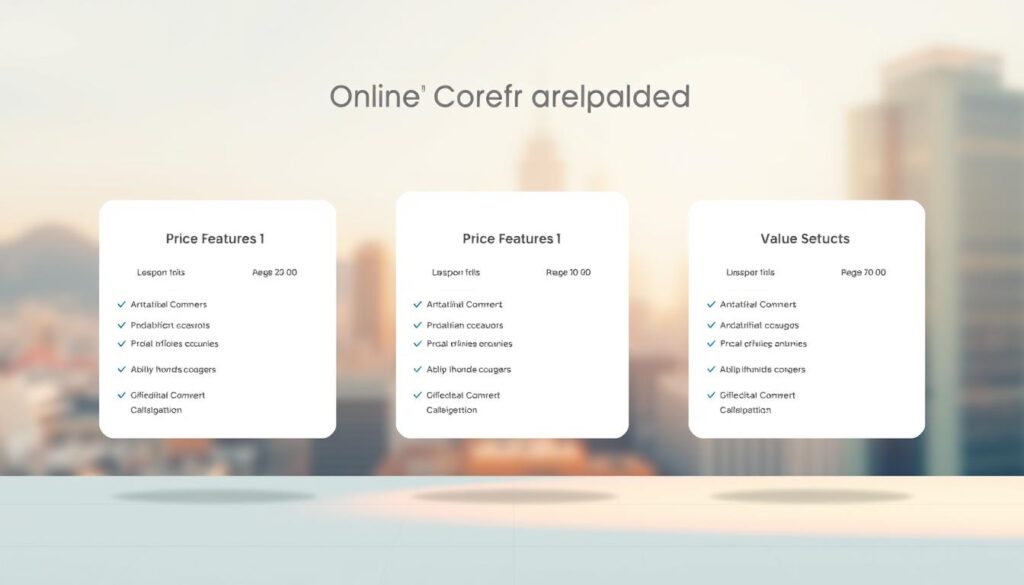
Paid plans offer more advanced features. One platform’s basic plan costs $49 per month and includes unlimited courses. The other’s basic plan is priced lower but adds a 5% transaction fee. For established creators, higher-tier plans provide additional benefits like advanced analytics and no transaction fees.
Here’s a quick comparison of the pricing tiers:
| Feature | Platform A | Platform B |
|---|---|---|
| Free Plan | No transaction fees | 10% transaction fee |
| Basic Plan | $49/month, unlimited courses | Lower cost, 5% transaction fee |
| Pro Plan | $99/month, no fees | $99/month, no fees |
When choosing a plan, consider your long-term goals. If you’re just starting, a free or basic plan may suffice. For scaling your product, investing in a higher-tier plan can provide better value. Additionally, features like certificate generation and advanced marketing tools are often included in premium plans.
For more insights on creating your first course, check out this free course guide. It’s a great resource for beginners looking to maximize their online course platform experience.
Payment Processing and Transaction Fees
Payment processing and transaction fees are critical factors to consider when choosing an online course platform. These elements directly impact your revenue and the overall experience for your students. Understanding how each platform handles payments can help you make an informed decision.
Stripe, PayPal, and Global Options
Both platforms support popular payment gateways like Stripe and PayPal, ensuring smooth transactions for your students. However, one platform offers more advanced features, such as automated tax handling and VAT collection. This is particularly beneficial for creators with an international audience.
Global payment options are another key consideration. One platform allows payments in multiple currencies, making it easier to reach a worldwide audience. The other, while limited in currency support, compensates with faster payout times.
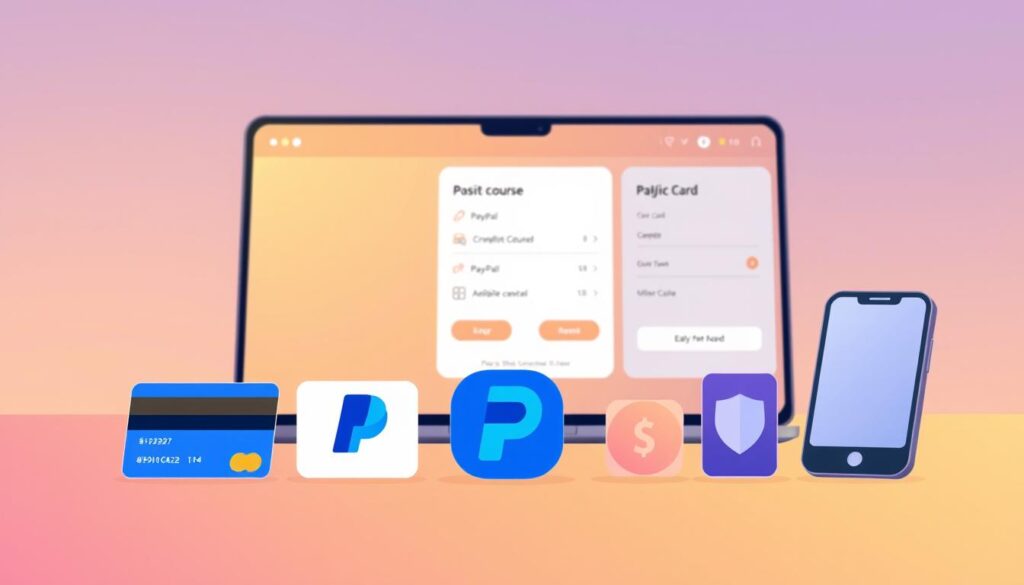
VAT Collection and Tax Handling
Automated VAT collection is a standout feature of one platform. It simplifies tax compliance for creators selling to EU customers. This feature automatically calculates and collects VAT, reducing the administrative burden.
In contrast, the other platform leaves tax handling to the creator. While this offers more control, it can be time-consuming for those unfamiliar with tax regulations. Here’s a quick comparison of the payment processing features:
| Feature | Platform A | Platform B |
|---|---|---|
| Payment Gateways | Stripe, PayPal, global options | Stripe, PayPal |
| Tax Handling | Automated VAT collection | Manual tax handling |
| Transaction Fees | No fees on all plans | 10% fee on free plan, 5% on basic |
Transaction fees can significantly affect your earnings. One platform charges no fees on any plan, allowing you to keep all your revenue. The other includes fees on its free and basic plans, which can add up over time.
“Choosing a platform with no transaction fees ensures you maximize your earnings, especially as your course sales grow.”
For more insights on optimizing your course revenue, check out this free course guide. It’s a great resource for creators looking to enhance their course creation and payment strategies.
Customizations and Branding Options
Branding plays a pivotal role in creating a memorable online course experience. Customization options allow you to align your platform with your unique style, building trust and recognition with your audience. Whether it’s designing sales pages or tailoring the course player, these features can significantly enhance your course’s professional appeal.
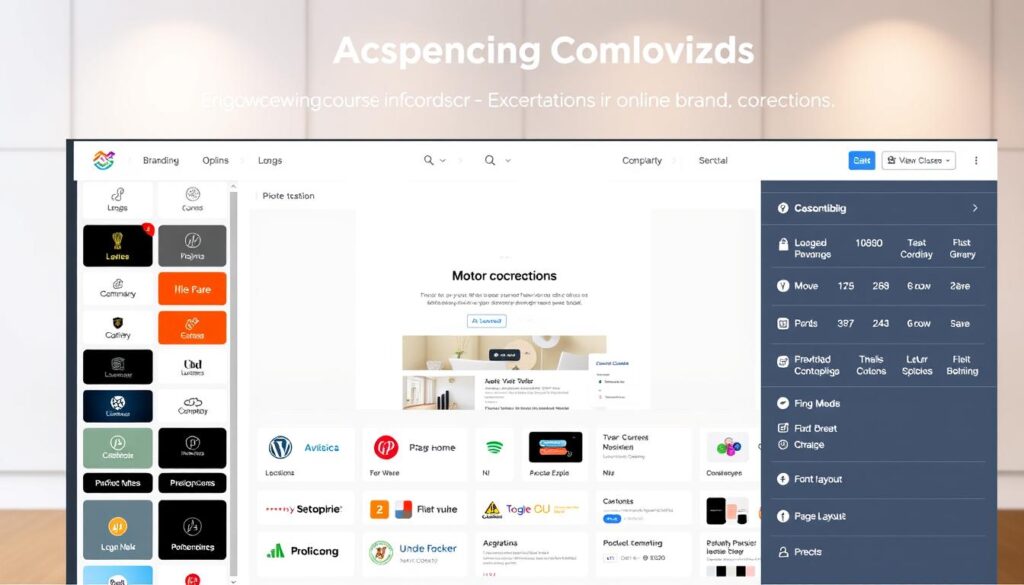
Sales Page Design and Templates
One platform stands out with its extensive library of customizable templates. These templates are tailored to various niches, making it easier to create a professional look without starting from scratch. Whether you’re in fitness, business, or creative arts, there’s a design that fits your needs.
Another platform, while offering basic templates, requires HTML/CSS knowledge for deeper customization. This can be a hurdle for beginners but provides flexibility for advanced users. Both platforms address common user questions about design flexibility, ensuring you can create a cohesive brand experience.
Course Player and Website Customization
The course player is where your students engage with your content, and customization here is crucial. One platform offers a dynamic course player that supports multimedia integration, quizzes, and interactive elements. This enhances the learning experience and keeps students engaged.
Website customization is another area where platforms differ. One allows you to fully personalize your site’s appearance, from colors to fonts, without coding. The other, while functional, requires technical skills for advanced changes. These options cater to different levels of expertise, ensuring you can create a platform that reflects your vision.
“Customization isn’t just about aesthetics—it’s about creating a seamless experience that resonates with your audience.”
For those focused on creation, one platform’s tools make it easy to design and update your course materials. Its drag-and-drop editor simplifies the process, even for beginners. The other platform, while offering similar tools, may require additional steps for advanced personalization.
Ultimately, the right customization options depend on your goals and technical skills. Whether you prioritize ease of use or advanced design capabilities, understanding these features will help you make an informed decision.
Reporting and Analytics Tools
Tracking student progress and course performance is essential for any course creator. Detailed analytics provide insights into how your content is resonating and where improvements are needed. Both platforms offer reporting tools, but their depth and focus differ significantly.
One platform excels in providing basic yet comprehensive dashboards. These tools track student activity, quiz performance, and engagement levels. This data helps you identify which lessons are most effective and where students may struggle. For example, you can see how many students completed a quiz or watched a video to the end.
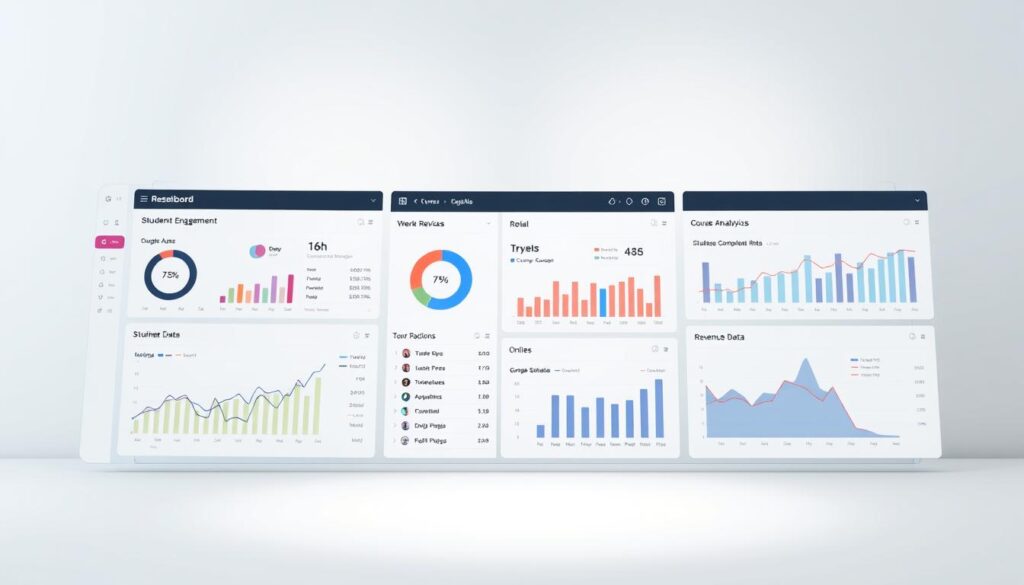
In contrast, the other platform offers more advanced analytics, including detailed sales reports. These insights are invaluable for optimizing your marketing strategy. You can track revenue, conversion rates, and even affiliate performance. This level of detail is particularly useful for scaling your course business.
“Analytics aren’t just numbers—they’re the roadmap to refining your course and maximizing its impact.”
Understanding these metrics is critical for making data-driven decisions. For instance, if a specific lesson has low completion rates, you might consider revising the text or adding more interactive elements. Similarly, sales reports can help you identify which marketing campaigns are most effective.
Here’s a quick comparison of the reporting features:
| Feature | Platform A | Platform B |
|---|---|---|
| Student Activity | Basic tracking | Detailed engagement metrics |
| Quiz Performance | Completion rates | Question-level analysis |
| Sales Reports | Revenue tracking | Conversion and affiliate insights |
For course creators, these tools are more than just numbers—they’re actionable insights. Whether you’re refining your content or optimizing your marketing strategy, robust analytics can make all the difference. By leveraging these tools, you can create a more effective and engaging learning experience for your students.
Community and Support Options
Reliable support and community resources are essential for course creators to thrive in the competitive online education space. Whether you’re troubleshooting an issue or seeking advice, having access to timely and effective support can make a significant difference in your experience.
Customer Support and Live Chat
When it comes to customer support, both platforms offer distinct advantages. One platform is known for its responsive support, including weekend availability, ensuring users can get help when they need it most. This is particularly valuable for creators managing courses across different time zones.
In contrast, the other platform excels with its live chat feature, which is highly valued by creators. Live chat provides instant assistance, reducing downtime and allowing you to resolve issues quickly. Both platforms also offer ticketing systems for more complex inquiries, ensuring all concerns are addressed thoroughly.

Knowledge Base and Resource Access
A comprehensive knowledge base is a cornerstone of effective support. One platform provides extensive resources, including tutorials, FAQs, and step-by-step guides. These materials empower users to find solutions independently, saving time and effort.
The other platform also offers a robust knowledge base but stands out with its community forums. These forums allow creators to share tips, ask questions, and learn from each other’s experiences. This collaborative environment fosters a sense of community and continuous learning.
“Access to timely support and a wealth of resources can transform your course creation journey, ensuring you stay focused on delivering value to your students.”
Here’s a quick comparison of the support features:
| Feature | Platform A | Platform B |
|---|---|---|
| Live Chat | Not available | Available on higher-tier plans |
| Weekend Support | Yes | No |
| Knowledge Base | Extensive tutorials and FAQs | Community forums and guides |
Both platforms provide comprehensive support, but their accessibility and focus differ. Whether you prioritize live chat or weekend availability, understanding these options will help you choose the right platform for your needs.
In-Depth Thinkific vs. Teachable Comparison
When deciding on the best platform for your online courses, a detailed comparison can reveal key differences that impact your experience. Testing both platforms with identical courses highlights subtle variations in functionality and ease of use. Let’s dive into the findings to help you make an informed choice.
One of the first things to consider is course creation speed. Real-world testing shows that one platform allows creators to set up courses faster, saving valuable time. The other, while slightly slower, offers more advanced customization options, making it ideal for those who prioritize design flexibility.
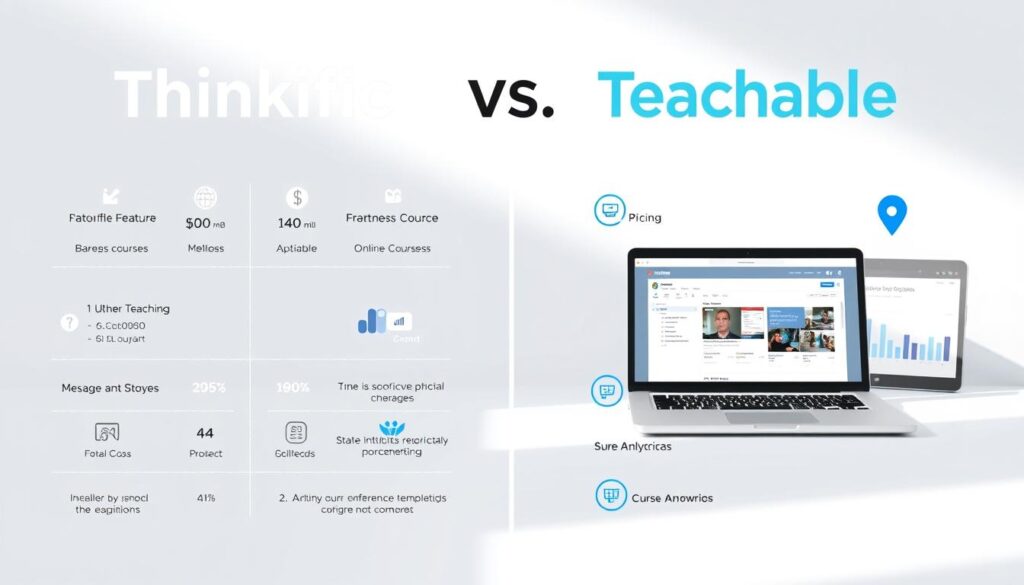
User feedback also plays a crucial role. Many creators appreciate the intuitive interface of one platform, which simplifies the process of building and managing courses. On the other hand, the second platform’s robust analytics tools provide deeper insights into student performance, helping educators refine their content.
Here’s a quick breakdown of key differences:
- Course Player Design: One platform offers a more dynamic player with multimedia support, while the other focuses on simplicity.
- Integration Options: One platform integrates with over 90 apps, providing greater flexibility, while the other focuses on essential tools.
- Fee Structures: One platform charges no transaction fees, while the other includes fees on lower-tier plans.
Customization is another critical area. One platform provides extensive branding options, allowing creators to align their courses with their unique style. The other, while offering basic customization, requires technical skills for advanced changes.
“The right platform can transform your course creation process, offering tools that save time and enhance the learning experience.”
Support options also vary. One platform is known for its responsive customer service, including weekend availability. The other excels with its live chat feature, providing instant assistance for users on higher-tier plans.
Ultimately, the choice depends on your priorities. Whether you value speed, customization, or advanced analytics, understanding these differences will help you select the best program for your needs.
Additional Considerations for Online Course Creators
Scalability and future-proofing are key factors when selecting an online course platform. Beyond the basics, creators should evaluate long-term needs and integrations to ensure their platform grows with their business.
One critical aspect is customization. A platform that allows you to tailor your course design and branding can significantly enhance your students’ experience. Look for tools that let you create unique sales pages, course players, and certificates to stand out in a competitive market.
Third-party integrations are another essential consideration. Platforms that support tools like email marketing, payment gateways, and analytics can streamline your workflow. For example, integrations with apps like Zapier or Mailchimp can save time and improve efficiency.
Advanced marketing and affiliate features are also worth review. Features like automated email campaigns, affiliate management, and detailed sales reports can help you scale your course business. These tools are particularly valuable for creators looking to expand their reach and revenue.
Here are some additional factors to keep in mind:
- Scalability: Ensure the platform can handle your growing number of courses and students.
- Learning Curve: Consider how easy it is to navigate and use the platform’s features.
- Group Features: Look for tools that allow you to organize students into groups or private classes for a more personalized experience.
Personal preferences and specific use cases can also tilt the balance one way or the other. For instance, if you prioritize customization and design flexibility, one platform may be a better fit. On the other hand, if advanced analytics and marketing tools are your focus, another platform might suit your needs.
“Choosing the right platform isn’t just about features—it’s about finding a solution that aligns with your long-term goals and vision.”
Finally, consider points of caution and recommendations from review data. For example, some platforms may charge transaction fees or have limited support options. Understanding these nuances can help you make an informed decision for long-term success.
By evaluating these additional factors, you can choose a platform that not only meets your current needs but also supports your future growth as a course creator.
Conclusion
Selecting the right platform for your online courses can shape your success as an educator. Both platforms offer unique strengths, making them excellent choices for different needs. One shines in design flexibility, allowing you to create visually appealing courses. The other excels in advanced features, ideal for pro users focused on analytics and marketing.
When deciding, consider factors like usability, pricing, and support. Customization options and ease of use are critical for creating a seamless learning experience. Both platforms are well-suited for launching professional courses, ensuring your content reaches students effectively.
Ultimately, the best choice depends on your specific goals and preferences. Take time to evaluate your needs and choose the platform that aligns with your long-term vision. Start building your course today and empower your students with the right tools for success.

